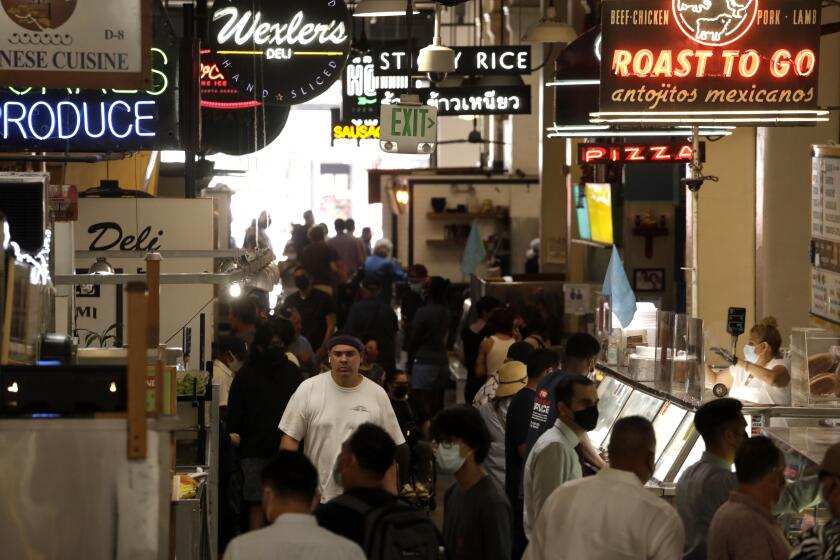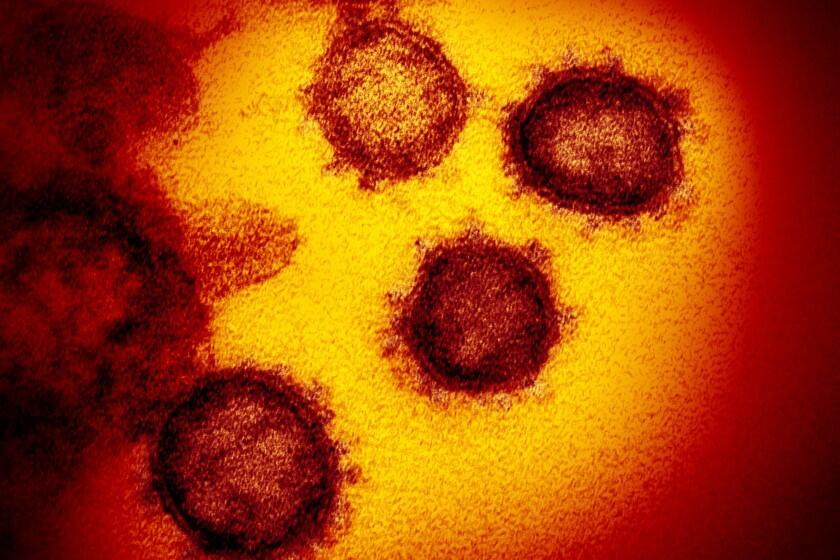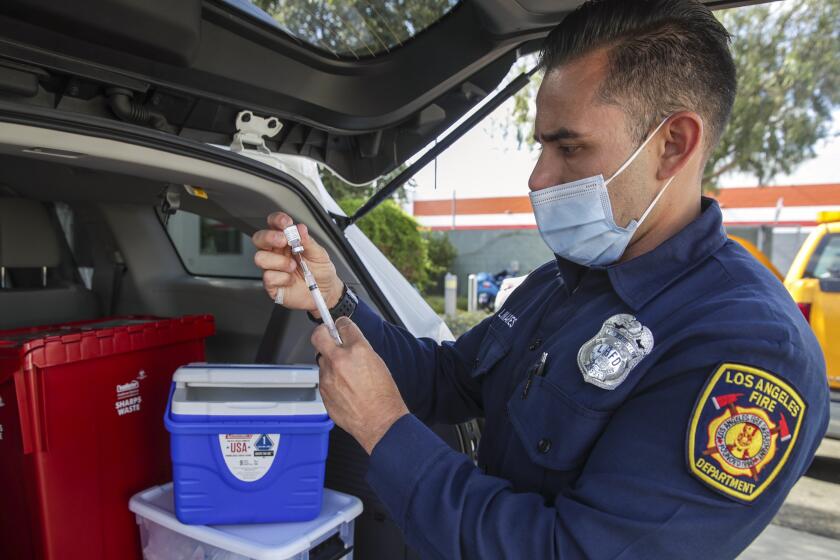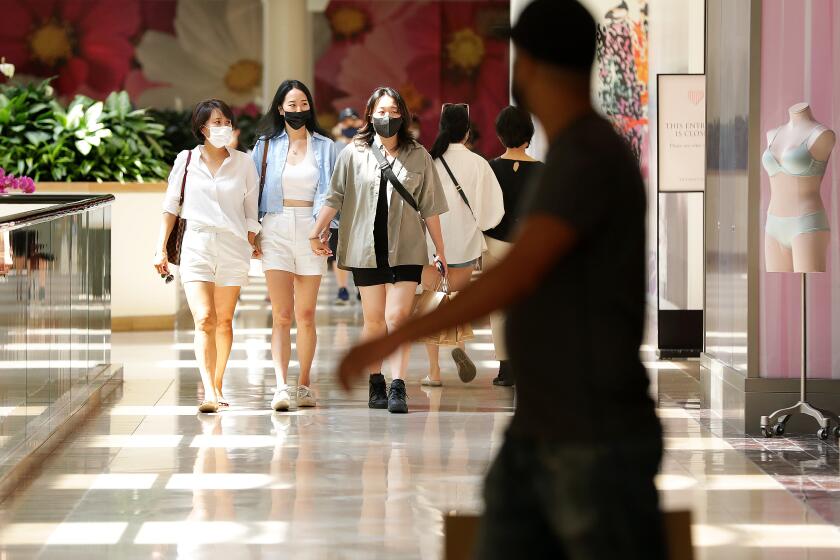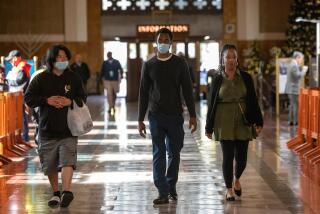Fears that Delta variant could ‘wreak havoc’ in L.A. prompted call to wear masks indoors
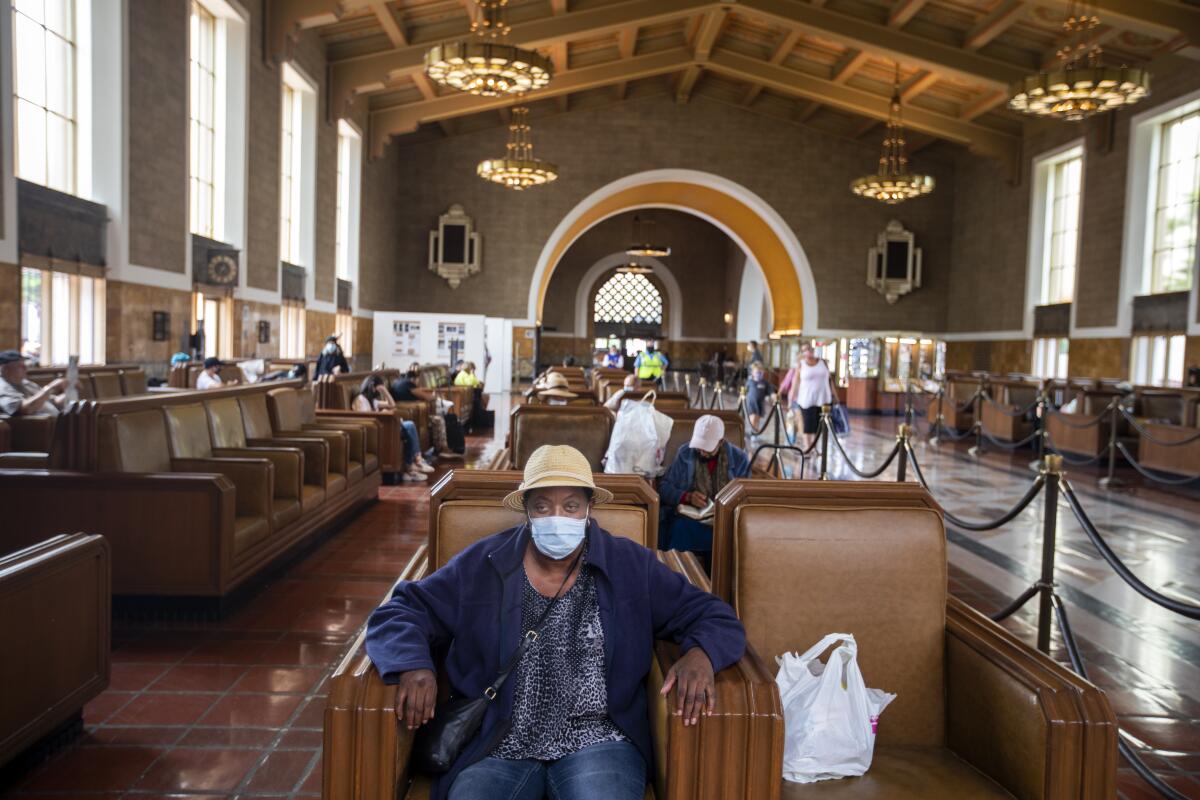
- Share via
California is just two weeks into its long-awaited reopening, but already a new coronavirus threat has prompted Los Angeles County health officials to request a voluntary rollback of one of the freedoms fully vaccinated people only recently began to enjoy.
The county’s recommendation this week that everyone — regardless of inoculation status — should wear face coverings in public indoor settings as a precaution, given the presence of the worrisome Delta variant of the coronavirus, underscores that speed bumps may still lie ahead on the road to pre-pandemic normalcy.
It also illustrates the current landscape in the long-running battle against COVID-19: one where those who have had their shots may be asked to give a little to help shield those who haven’t.
“There’s a lot of give-and-take in our communities,” L.A. County Public Health Director Barbara Ferrer said during an interview Tuesday. “And this is the time for vaccinated people to give, I think, and protect others.”
While not a mandate, L.A. County is requesting that residents go beyond guidance issued at the state and federal level, which affirms that fully vaccinated residents can go maskless in most situations, including indoors.
Ferrer said the recommendation stemmed from a few interlinked factors. The county has seen a slight uptick in community coronavirus transmission as of late, and the presence of the Delta variant — which officials say is perhaps twice as transmissible as the conventional coronavirus strains — could exacerbate what’s still a minor trend.
The county is also seeing persistent gaps in vaccination coverage, with Black and Latino Angelenos still inoculated at lower rates than their white, Asian American and Native American counterparts.
“If there’s one lesson we’ve learned over the last 18 months it’s that, with a new virus, there are lots of unknowns,” Ferrer said. “And every time we get a new variant of concern that’s identified, it takes some time to really understand who’s getting infected and how easily they’re getting infected and what are the consequences of that infection.”
Of particular concern, she added, is that “there’s a lot of opportunity here, because we have large numbers of unvaccinated among our workers, to have large outbreaks that really can once again wreak havoc in families and communities.
“We have the tools to prevent that from happening,” Ferrer said.
With the highly contagious Delta variant of the coronavirus continuing to spread statewide, the Los Angeles County Department of Public Health is recommending that all residents wear masks in public indoor spaces — regardless of whether they’ve been vaccinated for COVID-19.
On Tuesday, Lauren Caruso pulled a cloth mask over her face as she stood patiently in line at Pressed Juicery in Venice.
She was the only one inside to do so.
Caruso, a 42-year-old lawyer, is one of the fully vaccinated Californians for whom masking up remains a way of life.
“It’s an extra precaution I can take, and if it’ll save someone else’s life, why not do it?” she said.
Caruso, like tens of thousands of other Californians, knows the pandemic’s pain personally: In the past year, her uncle and aunt both died from COVID-19.
A sign posted on the front door of Jinky’s Cafe in Santa Monica on Tuesday requested that all employees and guests wear facial coverings, regardless of vaccination status.
But in barista Julieanna Bravo’s mind, an overhaul of requiring people to wear masks is long overdue.
“You can still get sick, so what’s the point? If I get COVID-19, it’s inevitable,” the 25-year-old said.
Bravo and her assistant manager, Hari Arango, are both unvaccinated by choice, and said they adhere to the mask mandate because it’s required by their employer.
The Delta variant now makes up 14.5% of coronavirus cases analyzed so far this month in California, up from 4.7% in May.
As of now, the state is not following the lead of its most-populous county in recommending further mask wearing. The same rules that went into effect as part of California’s wider June 15 reopening — generally, that vaccinated people can shed their masks in most situations, while those who are unvaccinated need to keep theirs on indoors while in public — remain in place.
But “businesses have the option of requiring all customers to wear a mask, even if they’re already vaccinated, and local health jurisdictions may impose stricter guidance or provide additional recommendations as a result of local conditions,” said Dr. Tomás Aragón, director of the California Department of Public Health and the state’s public health officer.
Delta circulation has increased rapidly since the variant grabbed a foothold in California. As of last week, the variant — first identified in India and also known as B.1.617.2 — made up 14.5% of coronavirus cases analyzed during June.
In May, the proportion of sampled cases that were Delta was 4.7%, and in April it was a scant 1.8%, state public health data show.
But on Tuesday, Aragón said the variant now accounts for about 23% of sampled cases, “and we anticipate this percentage will increase.”
“The risk for COVID-19 exposure and infection will remain in California until we reach community immunity with vaccinations,” he said. “COVID-19 vaccines provide excellent protection from serious disease, even for the Delta variant.”
In L.A. County, vaccination rates are lower among Black and Latino residents. Health officials fear a disproportionate rise in COVID transmission.
The U.S. Centers for Disease Control and Prevention continues to advise that those who are fully vaccinated don’t need to wear masks in most situations, given the protection the shots provide — including against circulating variants.
The World Health Organization, on the other hand, says people should “wear a mask, especially in crowded, closed and poorly ventilated settings,” even after they’ve been vaccinated.
“I think the first message we want to be careful about is saying, ‘Once you’re vaccinated, you can just go ahead and do whatever,’” Dr. Bruce Aylward, senior adviser to the director-general at the WHO, said during a recent briefing. “Yes, you can reduce some measures, and different countries have different recommendations in that regard, but there’s still the need for caution.”
He added: “We still live in a world that is only partially vaccinated, that has a lot of susceptibility, a lot of vulnerability. So, what we’re saying is, once you’ve been fully vaccinated, continue to play it safe because you could end up as part of a transmission chain.”
COVID-19 vaccines appear to protect against the Delta variant, but there’s real concern about the vulnerability of people who aren’t yet vaccinated.
It’s also important to recognize, officials and health experts say, that vaccination rates vary widely between countries, states, counties and communities — meaning some areas remain far more exposed to a potential outbreak than others.
Six of California’s 58 counties, for instance, have recorded more than 70% of their residents receiving at least one vaccine dose to date, according to data compiled by The Times.
But that rate is below 40% in 10 others. In L.A. County, it’s 58.2%.
While there are some who are ardently opposed to getting vaccinated, Ferrer said others may simply need more time and information before they’re convinced of the shots’ efficacy and safety.
She also noted that many county residents are still too young to be eligible, or may have a health condition that prevents them from rolling up their sleeves.
But until enough people are vaccinated to end the pandemic once and for all, Ferrer said it’s incumbent on Angelenos to look out for one another.
“We’ve gotten through this pandemic by taking care of each other,” she said. “We need to continue to take care of each other.”
Times staff writer Rong-Gong Lin II contributed to this report.
More to Read
Sign up for Essential California
The most important California stories and recommendations in your inbox every morning.
You may occasionally receive promotional content from the Los Angeles Times.
